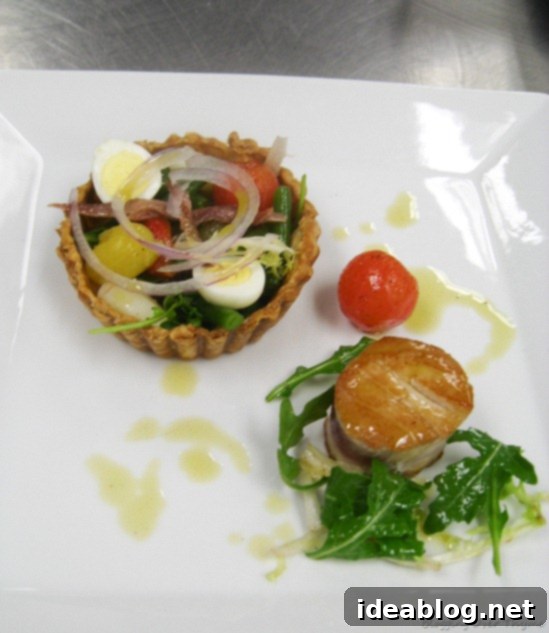Culinary School Week 3: Mastering French Classics from Modern Nicoise to Flambéed Crepes Suzette
Phew! Week 3 of Phase II at culinary school has officially drawn to a close, and once again, I’ve navigated the intensity of another Market Basket challenge. These past three weeks have proven to be an exhilarating blend of challenging techniques, demanding schedules, and an overwhelming influx of information. Yet, despite the exhaustion, I can already sense the profound learning and skill development that will undoubtedly unfold over the next two months. That being said, the arrival of the weekend is a truly welcome reprieve, promising much-needed rest after a week brimming with culinary revelations.
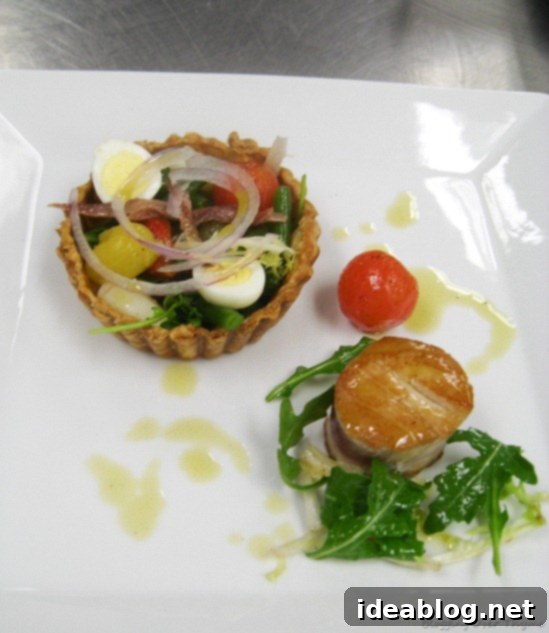
The Art of Modern Nicoise Salad: A Classic Reimagined
Thursday’s menu kicked off with a truly time-intensive creation: a classic Nicoise Salad. This iconic French Riviera dish, traditionally hailing from Nice, is celebrated for its vibrant medley of fresh ingredients. The conventional rendition typically features robust components like tuna (often canned), tender green beans, briny olives, perfectly hard-boiled eggs, crisp red onion, ripe tomatoes, piquant anchovies, sweet peppers, and hearty potatoes. However, in our pursuit of culinary innovation, we embarked on a journey to craft a significantly more modern and visually stunning presentation of this beloved salad, while meticulously preserving every traditional component that defines its character.
Our approach aimed not just for aesthetic appeal, but also to elevate the textural and flavor experience. Instead of a simple assemblage, we focused on meticulous preparation of each element. One of the most distinctive features of our modern Nicoise was the presentation: the main salad components were elegantly served within a delicate puff pastry shell. These shells, ingeniously crafted from leftover puff pastry trimmings, provided a flaky, buttery foundation that added an unexpected layer of richness and sophistication to the dish. We lined these shells with a small amount of lightly dressed mixed greens, providing a fresh, peppery counterpoint to the richer elements.
The transformation continued with the individual salad components, each prepared with an emphasis on miniature perfection and precise execution. For instance, instead of standard chicken eggs, we opted for delicate hard-boiled quail eggs, their tiny size adding a touch of elegance. Our potatoes were not simply boiled; they were meticulously tourneed, a classical French knife cut that shapes vegetables into an appealing seven-sided oval, ensuring uniform cooking and a refined appearance. Green beans were blanched to vibrant perfection and then meticulously sliced into small, uniform strips. Yellow and red cherry tomatoes were blanched and carefully peeled, intensifying their natural sweetness and creating a smooth texture. Finally, bell peppers were roasted to bring out their inherent sweetness, before being expertly cut into fine julienne strips. Each of these miniature elements was then carefully layered and arranged within the puff pastry shell, designed to showcase the beauty and freshness of the ingredients in a truly artistic fashion.
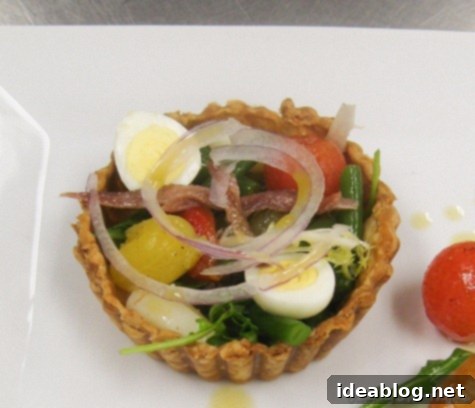
Perhaps the most significant departure from the classic recipe, and a true highlight of our modern rendition, involved the tuna. Eschewing the traditional canned variety, we utilized an exceptionally high-quality, sushi-grade tuna tenderloin. This premium cut was tightly rolled into a log using plastic wrap, then chilled to firm it up before being precisely sliced into small medallions. These medallions were then given a quick, hot sear on both sides, creating a beautiful crust while crucially maintaining a perfectly rare, melt-in-your-mouth center. This technique not only showcased the superior quality of the fish but also added a luxurious texture and depth of flavor that elevated the entire dish. While a Nicoise Salad might not always be celebrated as the world’s most inherently delicious dish, this innovative presentation and refined version undeniably injected an exciting and delightful twist into a time-honored classic.
Mastering the Main Course: Pork Tenderloin and Pommes Mousseline
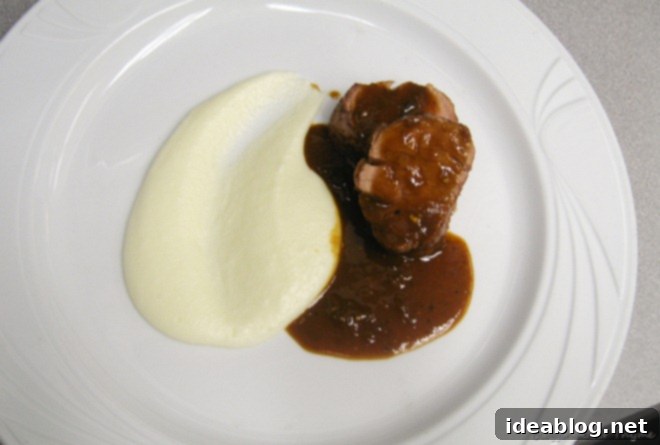
For our main course, we focused on precision and depth of flavor, preparing a perfectly cooked pork tenderloin. The tenderloin itself was seared to achieve a beautiful golden-brown crust and then gently roasted to the ideal internal temperature, ensuring it remained incredibly moist and tender. This exquisite piece of pork was then served with a rich and complex pan sauce, a testament to classical French culinary techniques. This sauce began with finely diced shallots, gently sautéed until translucent, forming an aromatic base. We then deglazed the pan with crisp white wine, scraping up all the delicious browned bits, before incorporating savory pork trimmings and a measure of Espagnol sauce. Espagnol, one of the five French mother sauces, is a deeply flavored, concentrated brown sauce made from a rich brown stock, roasted mirepoix, and roux, providing a profound umami foundation. After simmering and reducing to intensify its flavors, the sauce was carefully strained to achieve a silky-smooth consistency. To finish, we whisked in a small amount of pungent Dijon mustard, which added a bright, tangy note, and then stirred in beautifully sliced dried prunes, whose sweetness and chewiness provided an elegant counterpoint to the savory sauce.
The Decadence of Pommes Mousseline
Accompanying our tenderloin and its luxurious sauce were impossibly rich and smooth mashed potatoes, known in French cuisine as Pommes Mousseline. Let me emphasize, these potatoes were a true indulgence, likely containing more cream and butter than actual potato! The philosophy behind Pommes Mousseline is to achieve an unparalleled creamy texture and profound richness, and our version certainly delivered. To attain this ultimate smoothness, I even passed my portion through a tamis (a large, fine-mesh sieve), a traditional technique that removes any last hint of lumpiness, resulting in a velvety, almost ethereal consistency. To further enhance their creaminess and ensure they stayed exceptionally rich, we took an extra step: reducing the cream over the stovetop prior to adding it to the potatoes. This process removes much of the cream’s natural water content, concentrating its fats and creating an even thicker, more decadent base. It’s safe to say that calorie counting is far from the agenda when delving into classical French cooking, and I can scarcely fathom the caloric density of our Pommes Mousseline! Whether the small serving size truly compensates for this opulence remains an open question, in all honesty.
A Classic Sweet Finish: Crepes Suzette
Lastly, we concluded our culinary journey with a relatively simple yet utterly charming French dessert: crepes suzette. While the dessert itself is straightforward, the process was time-consuming simply because we had to prepare a substantial quantity of crepes to perfect our technique. A key learning point for us was the trick of using *browned* butter in our crepe batter. This seemingly small alteration makes a significant difference, imparting a wonderfully nutty, deeper flavor profile to the delicate crepes, elevating them from merely thin pancakes to something truly special.
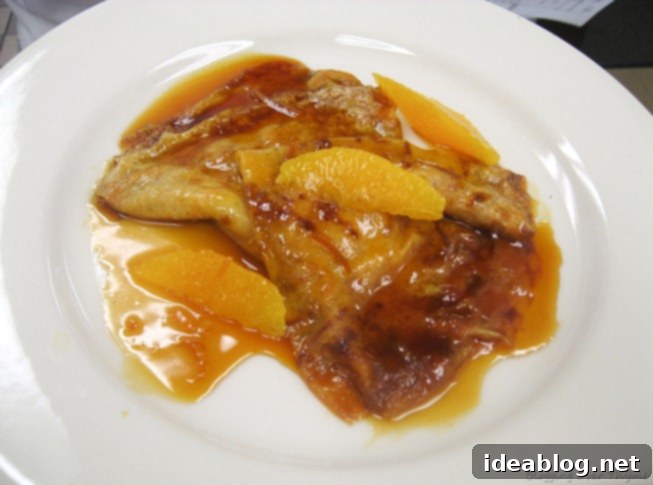
The iconic sauce for Crepes Suzette, into which the beautifully folded crepes are nestled, is a masterpiece of sweet and citrusy notes. It begins with caramelized sugar, creating a rich, golden base. To this, we added freshly squeezed orange juice and fragrant orange zest, infusing the sauce with a bright, tangy citrus burst. The defining ingredient, however, is Grand Marnier, an orange-flavored liqueur. This potent addition is crucial for the grand finale: flambéing the sauce. The alcohol ignites, creating a dramatic burst of flame that cooks off the harsh alcohol notes while leaving behind an intensified, caramelized orange essence. To finish, and in keeping with classic French tradition, we swirled in a small amount of butter – a final touch that adds an irresistible sheen and a luxurious mouthfeel. This dessert is not only delicious but also wonderfully practical; the crepes can be prepared well in advance, allowing for a quick, impressive assembly at the very last minute, perfect for entertaining.
Beyond the Kitchen: Externship Insights and Market Basket Challenge
Thursday afternoon transitioned from practical cooking to invaluable career development. We reconvened in the classroom for an insightful externship panel. This session featured recent graduates who graciously shared a synopsis of their experiences working in various restaurant environments. Their advice was incredibly pertinent, covering everything from navigating the demanding pace of professional kitchens to mastering specific skills and understanding kitchen dynamics. They candidly answered all our questions, providing a realistic glimpse into the world we aspire to enter.
During this session, we also received the highly anticipated ingredients for our second (and first official graded) Market Basket challenge, scheduled for Friday. This challenge is a core component of our training, testing our creativity, improvisation, and technical skills under pressure with a limited set of mystery ingredients. The allocated ingredients for this round were: eggs, chicken, and tempered chocolate. Unfortunately, as is often the case when working against the clock in a professional setting, I don’t have any finished plate pictures from this challenge to share yet. However, rest assured, I will provide a detailed account of what my team and I ended up creating in my very next post!
The Next Big Step: My First Culinary Stage
Tomorrow marks a significant milestone: I will be heading to my first stage – a working interview – at a reputable restaurant in the area! For the sake of discretion and to maintain a professional approach, I’m going to hold off on revealing the names of the restaurants until I have officially made a decision about where I will be continuing my journey. I am scheduled to arrive at 1:00 pm and will be staying through the entirety of the service. My emotions are a complex mix of nerves, palpable excitement, and a healthy dose of intimidation. This “stage” represents a real-world test of everything I’ve learned, an opportunity to experience the high-pressure environment of a professional kitchen firsthand, and a chance to make a lasting impression. I anticipate it will be an incredibly demanding but equally rewarding experience. Full details and reflections are definitely to come in future updates…
And now, after a week packed with intense learning, challenging tasks, and exciting prospects, I am off to bed to catch up on some much-needed rest!
